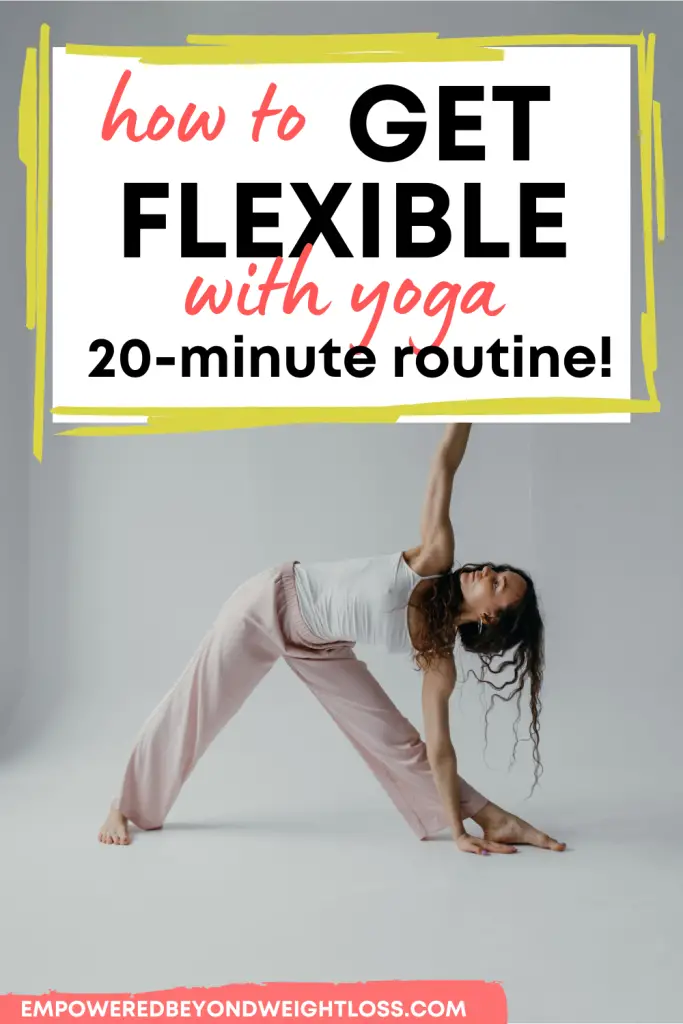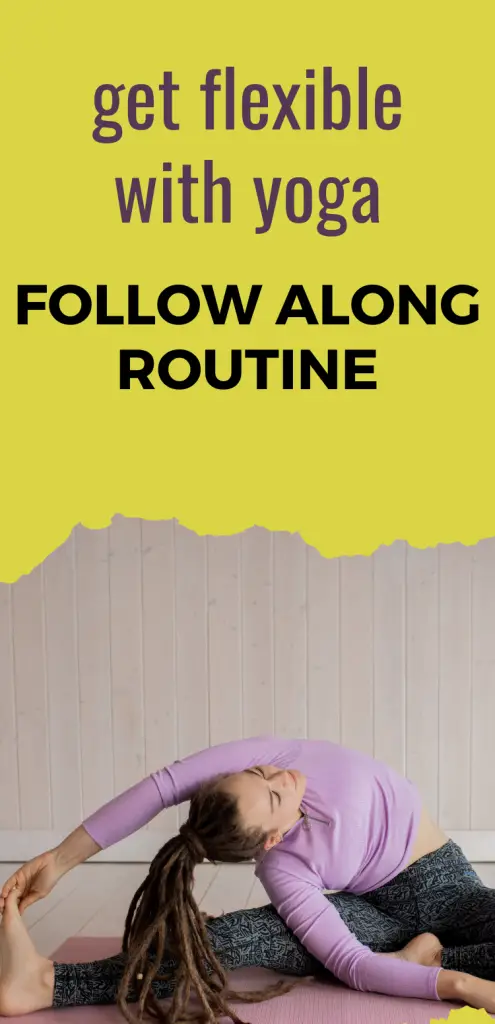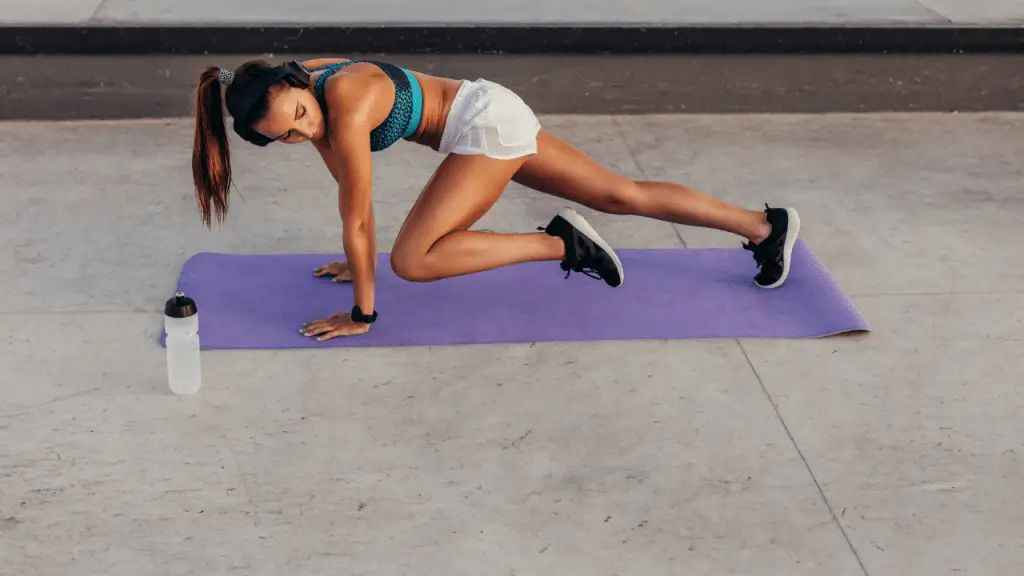Wondering how to get flexible with yoga? Today, I provide a follow-along routine to get flexible with yoga. Furthermore, I explain everything you need to know to go from stiff to bendy using yoga, even if you have never been flexible before.
Best Type of Yoga for Flexibility
To understand why I recommend certain types of yoga over others to increase your flexibility, you need to know how flexibility training works and how yoga improves your flexibility. Let’s dive right in.
How to Increase Your Flexibility Efficiently
First, let’s keep in mind that the point of becoming more flexible is increasing your range of motion. Moreover, regular flexibility training can also have additional benefits, such as reducing muscle soreness, improving posture, and decreasing stress levels. Your range of motion refers to the extent of movement you can achieve through flexibility and strength.
Flexibility training can take many forms, including static stretching, dynamic stretching, and proprioceptive neuromuscular facilitation (PNF) stretching. Each type of stretching has its unique benefits and may be appropriate for different individuals or situations. However, some stretching protocols are more efficient. For example, static stretching is more effective than dynamic stretching to increase your range of motion. Furthermore, the most efficient protocol is to hold each stretch for at least 30 seconds at a level 4 or so of discomfort. Listen to the Huberman Podcast on flexibility for a more in-depth explanation.
Want my step-by-step roadmap to increase your flexibility in the most efficient way?
Check out my Flexibility Transformation Program:

How Does Yoga Improve Flexibility
Yoga is an effective way to improve flexibility because it involves a variety of stretches and poses that target different muscle groups and joints in the body. Holding these poses for an extended period trains your central nervous system that these poses are safe for your body. Furthermore, over months, it can help lengthen and stretch muscles and connective tissues, improving flexibility and range of motion.
Additionally, regular yoga practice can help release tension and reduce stiffness, making it easier to move more freely and easily. Yoga also helps to improve proprioception, or body awareness, which can further enhance flexibility and prevent injury.
Finally, practicing yoga with proper alignment and technique can also help prevent overstretching or injury, ultimately improving overall flexibility and mobility.
Best Types of Yoga to Get Flexible
Several types of yoga can be particularly beneficial for improving flexibility:
- Hatha Yoga: Hatha yoga is a gentle and slower-paced style that emphasizes holding poses for an extended period. This can help to lengthen and stretch muscles, improve joint mobility, and increase flexibility.
- Yin Yoga: Yin yoga involves holding poses for several minutes, which can help stretch and lengthen connective tissues such as ligaments and fascia. This can increase flexibility and range of motion in the body.
- Restorative Yoga: Restorative yoga involves holding passive poses for an extended time, often with the support of props such as blankets and bolsters. This can help to release tension and tightness in the body, improving flexibility and mobility.
- Vinyasa Yoga: Vinyasa yoga is a more dynamic and flowing style that involves moving through a series of poses with breath awareness. This can help to increase blood flow to muscles and joints, improving flexibility and range of motion.
Ultimately, any yoga style can help improve flexibility when practiced consistently and with proper alignment and technique. It’s essential to listen to your body and work within your limitations, gradually working to increase your flexibility over time.
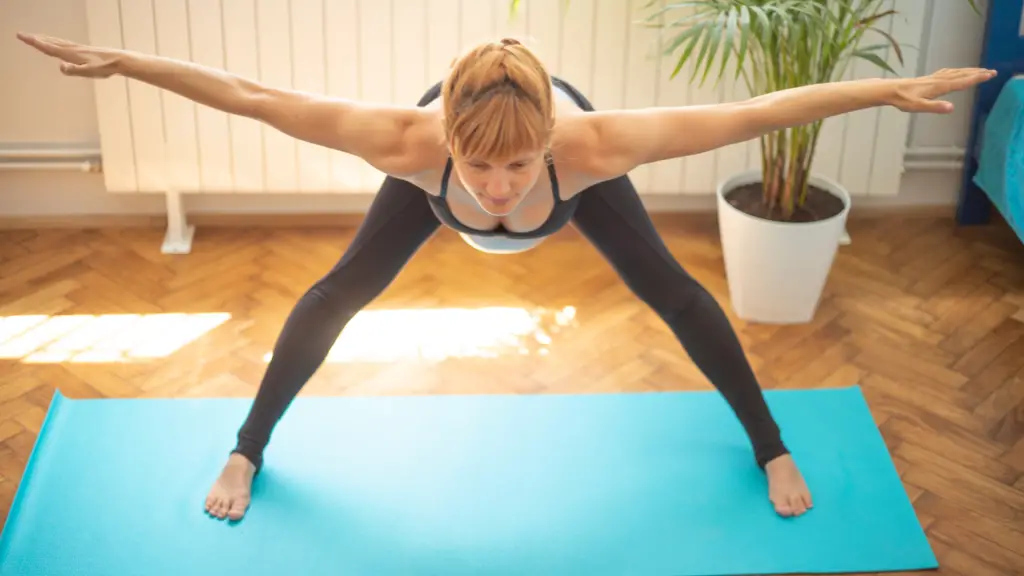
How to Get Flexible With Yoga
Yoga is an excellent way to improve flexibility, and there are several things you can do to become more flexible through your yoga practice. Here are some tips:
- Start with the basics: If you’re new to yoga or haven’t practiced in a while, begin with basic poses and gradually work your way up to more advanced ones. Start with simple stretches like seated forward fold or child’s pose, and gradually progress to more challenging poses.
- Practice regularly: Consistency is key when it comes to improving flexibility. Try to practice yoga at least 3-4 times a week, and aim for longer sessions as your body becomes more accustomed to the practice.
- Use props: Props such as blocks, straps, and bolsters can help you get into poses that might otherwise be difficult or inaccessible. For example, a block under your hand can make it easier to reach the floor in triangle pose.
- Focus on your breath: Breathing deeply and mindfully can help you relax into poses and release muscle tension. Try to breathe smoothly and steadily throughout your practice, and focus on using your breath to help you move deeper into poses.
- Be patient: Improving flexibility takes time and consistency, so don’t expect to see results overnight. Celebrate your progress along the way, and remember that every little bit counts.
- Take care of your body: Stretching should never be painful, so be gentle with yourself and listen to your body’s signals if you feel pain or discomfort, back off from the pose and try a modification or a gentler variation.
Remember, flexibility is just one of the many benefits of yoga. With regular practice, you’ll not only become more flexible but also stronger, more balanced, and more relaxed.

How to Get Flexible With Yoga Video Routine
This routine is perfect for beginners and intermediate yogis wanting to increase flexibility. We will work on your legs, back, and shoulders. Here’s a very brief summary of what you will find in my how to get flexible with yoga routine (we hold each flexibility pose for about a minute):
- Mountain pose
- Forward fold, flat back,
- Forward fold,
- Low and high lunge with lung drill
- Plank to chaturanga
- Chaturanga to updog
- Updog to cobra
- Cobra to chaturanga
- Chaturanga to plank
- Jump to forward fold
- Lung and triangle on the other side
- Forward Fold
- Pyramid
- Warrior 2
- Extended Side Angle
- Triangle
- Forward Fold
Yoga Poses for Flexibility for Beginners
Here are a few yoga poses for beginners that can help improve flexibility:
- Downward Facing Dog: Begin on your hands and knees, with your hands shoulder-width apart and your knees hip-width apart. Lift your hips up and back, straightening your arms and legs to create an inverted V shape. Keep your feet hip-width apart and your heels reaching toward the ground. Hold for several breaths.
- Child’s Pose: From Downward Facing Dog, lower your knees to the ground and sit back on your heels. Reach your arms forward and lower your forehead to the ground. This pose stretches the hips, thighs, and lower back.
- Triangle Pose: Begin in a standing position with your feet hip-width apart. Step your left foot back and turn it out to a 45-degree angle. Reach your left arm toward the ground and your right arm toward the ceiling,
- Seated Forward Fold: Sit on the ground with your legs extended in front of you. Inhale and reach your arms up overhead, lengthening through your spine. As you exhale, hinge forward from your hips and reach your hands toward your feet. Keep your knees slightly bent if needed, and relax your head and neck.
- Cobra Pose: Lie on your stomach with your hands under your shoulders and elbows close to your sides. Inhale and press your hands into the ground, lifting your chest and head up. Keep your shoulders down and away from your ears, and engage your back muscles to support the pose.
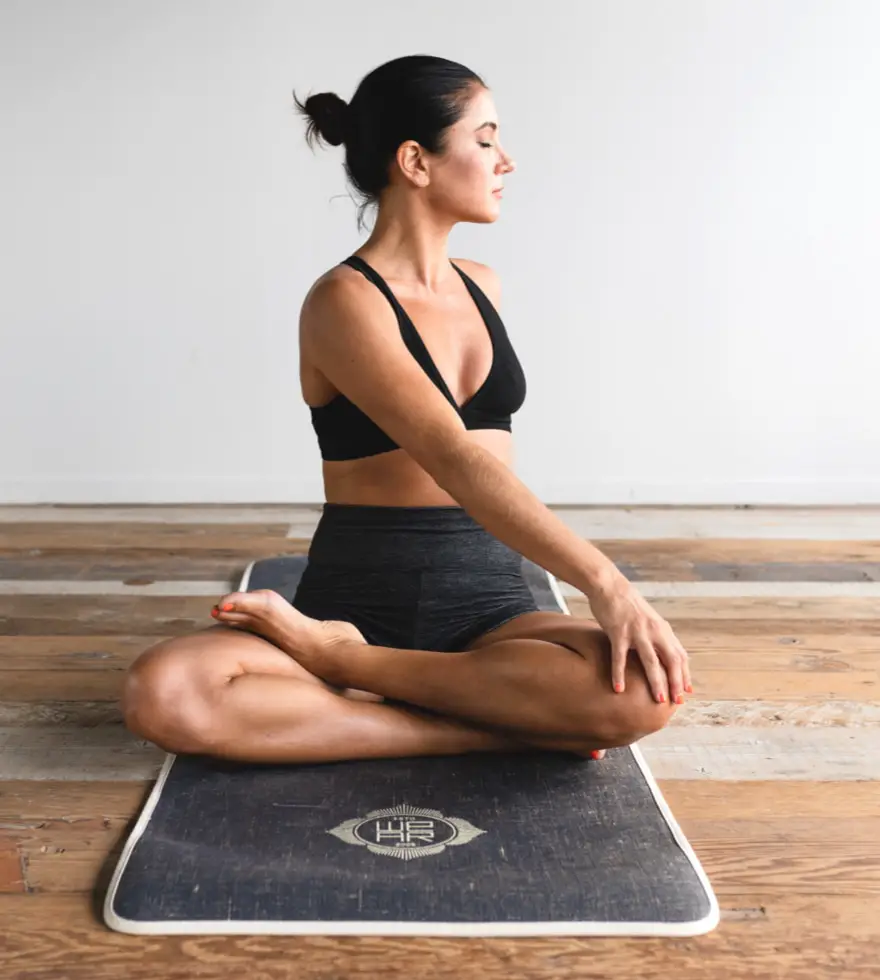
Yoga Poses for Flexibility and Strength
Yoga is my favorite all-in-one activity. Increasing your flexibility, strength, balance, and cardiovascular endurance is excellent!
Yoga for Flexibility and Strength for Beginners
Since you found this article because you wanted to learn how to get flexible with yoga, I assume you are more of a beginner and provide beginner yoga poses to increase your strength and flexibility. Plus, I recommend you read 5 Effective Yoga Poses for Strength and Flexibility
Here are some yoga poses that can help improve both strength and flexibility:
- Warrior II (Virabhadrasana II): This pose targets the legs, hips, and shoulders, helping to strengthen the lower body and increase flexibility in the hips.
- Downward Facing Dog (Adho Mukha Svanasana): This pose stretches the hamstrings, calves, and shoulders while building upper body strength and core stability.
- Bridge Pose (Setu Bandha Sarvangasana): This pose strengthens the glutes, hamstrings, and back muscles while stretching the chest and shoulders.
- Plank Pose (Phalakasana): This pose is great for core strength and stability, as well as building strength in the arms, shoulders, and legs.
- Triangle Pose (Trikonasana): This pose helps to strengthen the legs, hips, and core while also stretching the hamstrings, hips, and spine.
- Chair Pose (Utkatasana): This pose targets the thighs, glutes, and core, helping to build lower body strength and improve balance.
- Camel Pose (Ustrasana): This pose stretches the front of the body, including the hip flexors, chest, and shoulders, while strengthening the back and core.
- Boat Pose (Navasana): This pose targets the abs, hip flexors, and lower back, helping to build core strength and improve balance.
- Standing Forward Fold (Uttanasana): This pose stretches the hamstrings, calves, and spine while strengthening the legs and improving hip flexibility.
- Crow Pose (Bakasana): This arm balance builds upper body strength, core stability, and arm flexibility.
Always practice yoga poses with proper alignment, listen to your body, and consult a qualified yoga instructor if you are new to yoga or have any health concerns. Regularly practicing these poses and breathing techniques can help you develop strength and flexibility.

Yoga for Flexibility and Balance
Certainly! Here are some yoga poses that can help improve both flexibility and balance:
- Tree Pose (Vrksasana): This pose helps improve balance while stretching the hips and legs.
- Warrior III (Virabhadrasana III): This pose helps improve balance while stretching the hamstrings and lower back.
- Half Moon Pose (Ardha Chandrasana): This pose helps improve balance while stretching the hips and hamstrings.
- Extended Triangle Pose (Utthita Trikonasana): This pose helps improve balance while stretching the legs, hips, and spine.
- Eagle Pose (Garudasana): This pose helps improve balance while stretching the shoulders, hips, and thighs.
- Bound Angle Pose (Baddha Konasana): This pose helps improve hip and groin flexibility.
- Pigeon Pose (Eka Pada Rajakapotasana): This pose helps improve flexibility in the hips and glutes.
- Seated Forward Fold (Paschimottanasana): This pose helps improve hamstrings and lower back flexibility.
- Camel Pose (Ustrasana): This pose helps improve flexibility in the spine, chest, and shoulders while improving balance.
- Dancer Pose (Natarajasana): This pose helps improve balance while stretching the thighs and hips.
Always practice yoga poses with proper alignment, listen to your body, and consult a qualified yoga instructor if you are new to yoga or have any health concerns. Regularly practicing these poses and proper breathing techniques can help you develop flexibility and balance.

On Getting Started With Yoga Over 40
I started doing yoga when I was 43. I was very inflexible and never had been athletic (although, as a NASM personal trainer, I had been consistent with regular workouts like lifting weights and doing HIIT). Yoga changed everything for me! Working out is no longer an item I check off my list of things to do! I love working out as I am undeniably improving in strength, flexibility, and endurance.
For inspiration, you may enjoy seeing my 1-Year Yoga Transformation: Before and After Pictures. Furthermore, Starting Yoga at 40 or Later: Everything You Need to Know explains what you need to know when starting.
Lastly, check out my program page to save time and have a strategic plan of action to get in shape over 40.
In Summary
To become more flexible with yoga, start with basic poses and gradually work up to more advanced ones. Consistency is vital, so try to practice yoga regularly, use props to help you, focus on your breath, be patient, and take care of your body. With regular practice, you’ll not only become more flexible, but also stronger, more balanced, and more relaxed.
